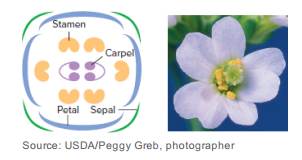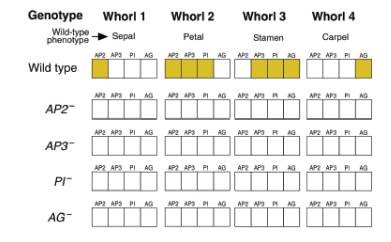
Concept explainers
In the plant Arabidopsis thaliana, every flower is constructed of four concentric whorls of modified leaves. The first whorl (whorl 1) consists of four green leaf-like sepals, whorl 2 is composed of four white petals, whorl 3 is made of six stamens bearing the pollen that houses the male gametes (sperm), and whorl 4 contains the two carpels, within which lie the ovules that hold the female gametes (eggs). As shown in the diagram that follows, a shorthand description of the wild-type flower pattern is: sepal, petal, stamen, carpel.

Scientists wanted to understand how this pattern of whorls arises. They generated Arabidopsis strains homozygous for randomly induced mutations and screened them for mutant flowers with an abnormal order or selection of floral organs. The interesting mutants identified fell into three phenotypic classes: (1) carpel, stamen, stamen, carpel; (2) sepal, sepal, carpel, carpel; (3) sepal, petal, petal, sepal.
The investigators found that all of the class 1 mutants were alleles of the same gene which they called APETELA2 (AP2). Class 2 mutants were alleles of either one of two genes, which were named APETELA3 (AP3) and PISTILLATA (PI). Finally, the class 3 mutants represented a single gene, AGAMOUS (AG). Molecular analysis showed that all four genes encode transcription factors.
Based on the
| a. | Complete the chart that follows to show how the model predicts the phenotype of flowers homozygous for mutations in each of the four genes. In the chart, the colored boxes represent genes that are expressed; the white boxes are genes that are not expressed. |
| b. | Scientists tested the flower patterning model with RNA in situ hybridization experiments using cDNA probes for each of the four genes. The goal was to see whether each gene’s mRNA was expressed in the precursor cells for each of the four whorls. What results would you predict with each probe on wild-type flowers? on AP2 mutants? on AG mutants? |
| c. | Another way the researchers tested their model for flower patterning was by making double mutants. What phenotypes does the model predict for each of the six double mutant combinations? [Hint: It will be helpful to expand the chart shown in part (a) for each possible double mutant.] |
| d. | Are the roles of the four genes described in this problem more similar to those of the segmentation genes or to those of the homeotic genes from Drosophila described in the text? |
Want to see the full answer?
Check out a sample textbook solution
Chapter 19 Solutions
Genetics: From Genes to Genomes
- "One of the symmetry breaking events in mouse gastrulation requires the amplification of Nodal on the side of the embryo opposite to the Anterior Visceral Endoderm (AVE). Describe one way by which Nodal gets amplified in this region." My understanding of this is that there are a few ways nodal is amplified though I'm not sure if this is specifically occurs on the opposite side of the AVE. 1. pronodal cleaved by protease -> active nodal 2. Nodal -> BMP4 -> Wnt-> nodal 3. Nodal-> Nodal, Fox1 binding site 4. BMP4 on outside-> nodal Are all of these occuring opposite to AVE?arrow_forwardIf four babies are born on a given day What is the chance all four will be girls? Use genetics lawsarrow_forwardExplain each punnet square results (genotypes and probabilities)arrow_forward
- Give the terminal regression line equation and R or R2 value: Give the x axis (name and units, if any) of the terminal line: Give the y axis (name and units, if any) of the terminal line: Give the first residual regression line equation and R or R2 value: Give the x axis (name and units, if any) of the first residual line : Give the y axis (name and units, if any) of the first residual line: Give the second residual regression line equation and R or R2 value: Give the x axis (name and units, if any) of the second residual line: Give the y axis (name and units, if any) of the second residual line: a) B1 Solution b) B2 c)hybrid rate constant (λ1) d)hybrid rate constant (λ2) e) ka f) t1/2,absorb g) t1/2, dist h) t1/2, elim i)apparent central compartment volume (V1,app) j) total AUC (short cut method) k) apparent volume of distribution based on AUC (VAUC,app) l)apparent clearance (CLapp) m) absolute bioavailability of oral route (need AUCiv…arrow_forwardYou inject morpholino oligonucleotides that inhibit the translation of follistatin, chordin, and noggin (FCN) at the 1 cell stage of a frog embryo. What is the effect on neurulation in the resulting embryo? Propose an experiment that would rescue an embryo injected with FCN morpholinos.arrow_forwardParticipants will be asked to create a meme regarding a topic relevant to the department of Geography, Geomatics, and Environmental Studies. Prompt: Using an online art style of your choice, please make a meme related to the study of Geography, Environment, or Geomatics.arrow_forward
- Plekhg5 functions in bottle cell formation, and Shroom3 functions in neural plate closure, yet the phenotype of injecting mRNA of each into the animal pole of a fertilized egg is very similar. What is the phenotype, and why is the phenotype so similar? Is the phenotype going to be that there is a disruption of the formation of the neural tube for both of these because bottle cell formation is necessary for the neural plate to fold in forming the neural tube and Shroom3 is further needed to close the neural plate? So since both Plekhg5 and Shroom3 are used in forming the neural tube, injecting the mRNA will just lead to neural tube deformity?arrow_forwardWhat are some medical issues or health trends that may have a direct link to the idea of keeping fat out of diets?arrow_forwardwhat did charles darwin do in sciencearrow_forward
 Biology 2eBiologyISBN:9781947172517Author:Matthew Douglas, Jung Choi, Mary Ann ClarkPublisher:OpenStax
Biology 2eBiologyISBN:9781947172517Author:Matthew Douglas, Jung Choi, Mary Ann ClarkPublisher:OpenStax Biology (MindTap Course List)BiologyISBN:9781337392938Author:Eldra Solomon, Charles Martin, Diana W. Martin, Linda R. BergPublisher:Cengage Learning
Biology (MindTap Course List)BiologyISBN:9781337392938Author:Eldra Solomon, Charles Martin, Diana W. Martin, Linda R. BergPublisher:Cengage Learning
 Human Heredity: Principles and Issues (MindTap Co...BiologyISBN:9781305251052Author:Michael CummingsPublisher:Cengage Learning
Human Heredity: Principles and Issues (MindTap Co...BiologyISBN:9781305251052Author:Michael CummingsPublisher:Cengage Learning Principles Of Radiographic Imaging: An Art And A ...Health & NutritionISBN:9781337711067Author:Richard R. Carlton, Arlene M. Adler, Vesna BalacPublisher:Cengage Learning
Principles Of Radiographic Imaging: An Art And A ...Health & NutritionISBN:9781337711067Author:Richard R. Carlton, Arlene M. Adler, Vesna BalacPublisher:Cengage Learning





